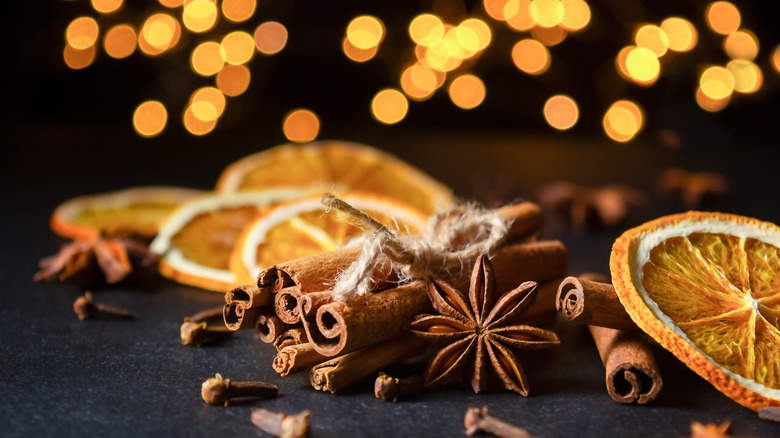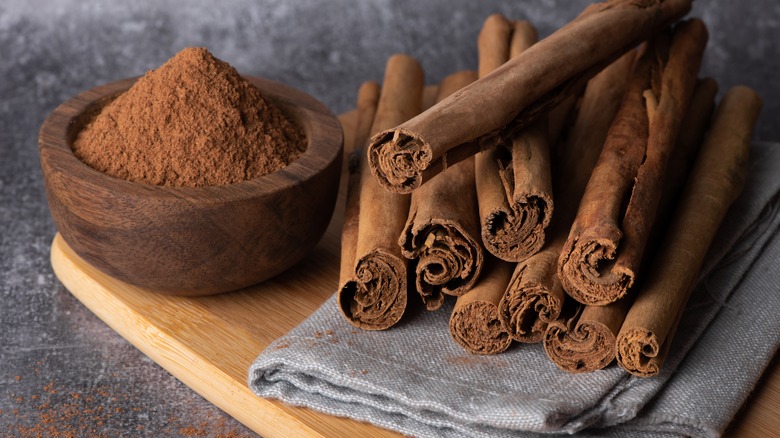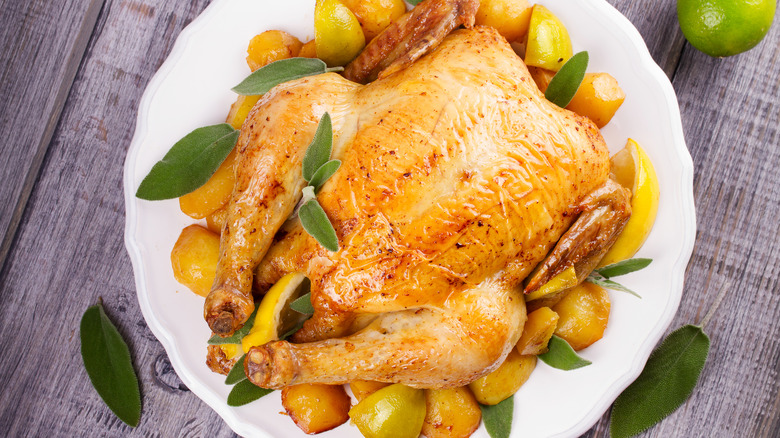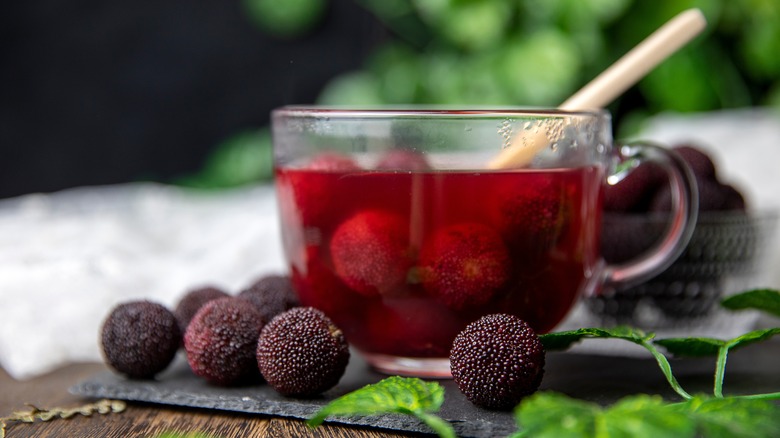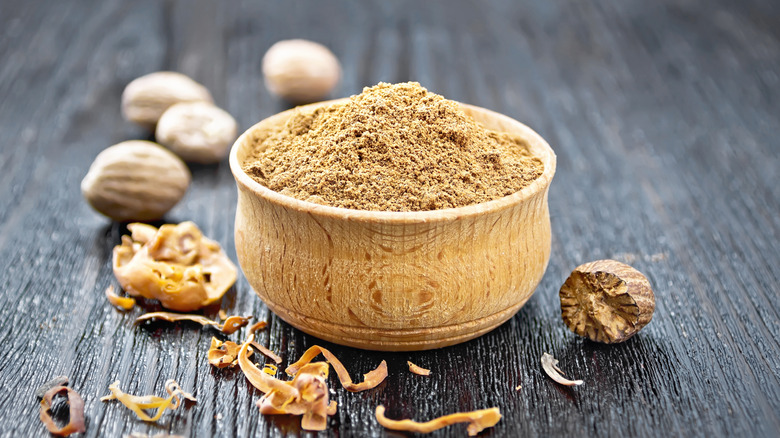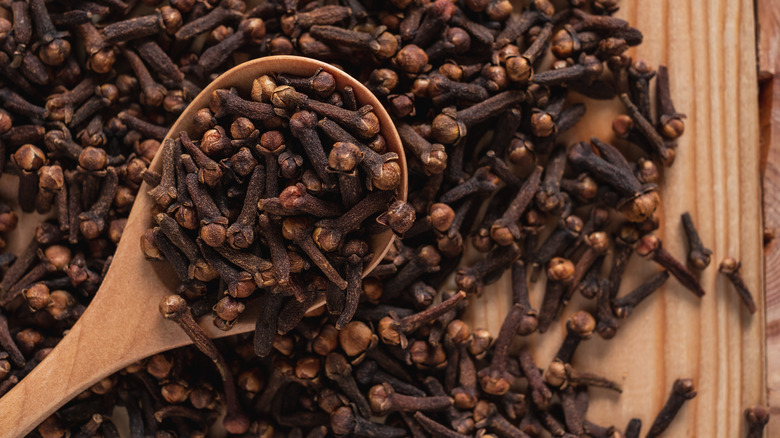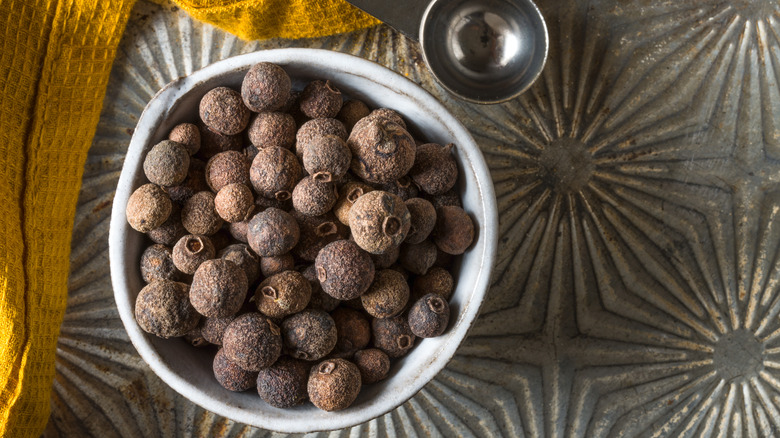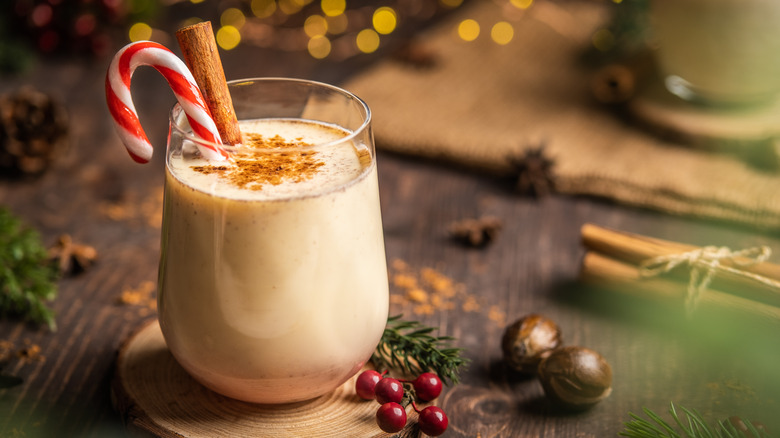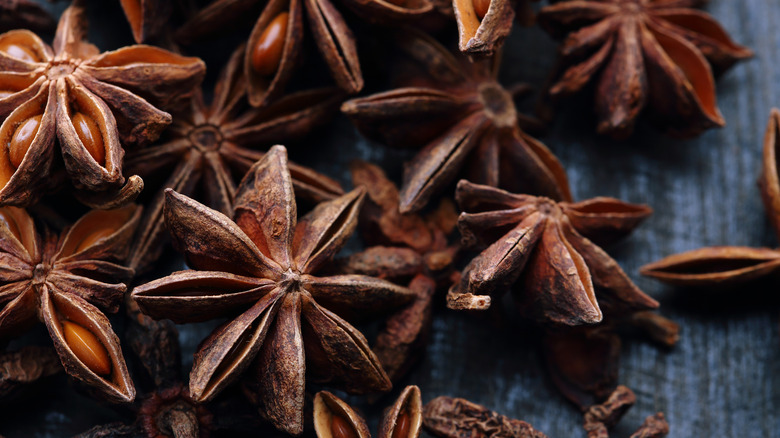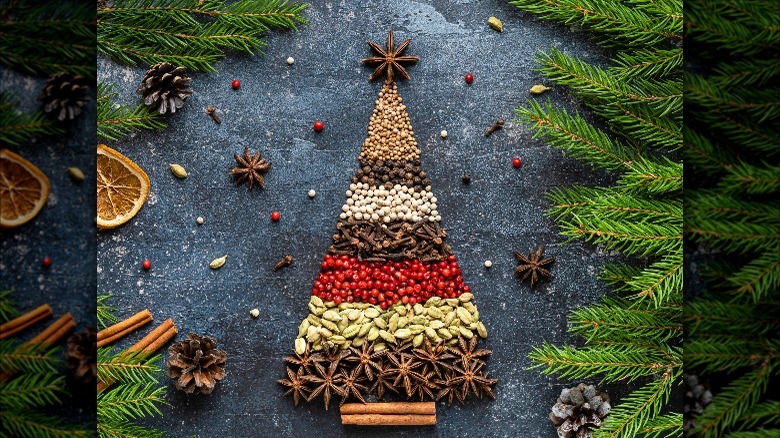How Holiday Herbs And Spices Can Benefit Your Health
It's hard to imagine the holidays without thoughts of walking into a home filled with the sweet aromatic memories of crisp seasonal herbs and notes of warm spices. There's just something about those familiar and comforting scents — be it from someone's amazing cooking or from our abundant holiday candle collection. While most of us think of holiday herbs and spices as just a way to enhance the flavor of a dish or to whisk us away on a seasonal journey for the senses, you may be surprised to find that, like most common household herbs and spices, there are loads of medicinal benefits and properties hidden within them.
In fact, according to registered dietician Samantha Cochrane, herbs and spices are a fantastic source of phytochemicals — healthy chemicals that can "help lower cholesterol, prevent cell damage, inhibit the growth of cancer cells, reduce inflammation, and provide many other benefits" (via The Ohio State University). So, essentially, adding seasonings to your dishes for consumption whenever possible is a great way to sneak in some health benefits, even when you're spicing up holiday cocktails and cookies.
While it may be tempting to use herbs and spices as an excuse for us to eat that whole gingerbread house for dessert, always remember that seasoning your meals is simply an added benefit to holiday cooking and that it shouldn't be used as a replacement for healthy eating or medical treatment. Now, let's take a deeper look into exactly what positive surprises you may find hidden in the most common herbs and spices used during this time of year.
Cinnamon
Cinnamon is a spice that many of us incorporate into sweet and savory dishes all year round, but from September to December, it's this holiday classic's time to shine. From mulled apple cider to dustings on cookies and pies, or from Christmas morning cinnamon rolls to cinnamon star bread, just a sprinkle of this ancient spice can amplify any recipe to the next level.
Beyond tasting great, however, cinnamon has been a staple in many civilizations for thousands of years, per Medical News Today. It's said to have been a prized delicacy in ancient Egypt and used throughout medieval Europe to combat common cold symptoms and joint pain. Fast forward to modern times, and we realize our ancestors were on to something. Current day studies have shown that cinnamon contains powerful health properties such as metabolism-boosting components, antioxidants and polyphenols, anti-inflammatories, heart disease- and cholesterol-lowering aspects, the ability to control blood sugar, inhibitors that prevent neurodegenerative diseases like Alzheimer's, anti-cancer benefits, and anti-bacterial and anti-viral components (via Healthline).
Expanding on this, dietitian Candace O'Neill tells the Cleveland Clinic, "[Cinnamon is] a good addition to your diet, and it can really be a helpful way to cut back on your intake of added sugars." She continues, "You can use the sweetness it brings to a recipe to cut the bitterness — or just add a little something to a meal."
Ginger
On a cold and bleak wintery December morning, everything seems a little more dull and gloomy as the fall foliage has made its way off of the trees and the sky is frozen over in shades of somber gray. Cutting the corner on your way to work, you catch sight of a sign at your local coffee shop that reads: "Stop in for one of our new gingerbread lattes!" Suddenly, as you decide to make your way in and take notice of the twinkling holiday lights and joyous music echoing around you, the smell of a freshly brewed gingerbread latte makes the ominous December weather not feel so bad.
Ginger is a spice that seems to just capture us in a warm seasonal hug and beckon us over to the fireside while we curl up in its spicy-yet-zingy embrace. When we're sick, ginger is the mother of the spices that offer us a soothing ease to our stomach aches and a calm to any upsets. "Ginger is fantastic," registered dietician Emma Slattery tells Johns Hopkins Medicine. "It's not just delicious. Gingerol, a natural component of ginger root, benefits gastrointestinal motility ― the rate at which food exits the stomach and continues along the digestive process. Eating ginger encourages efficient digestion, so food doesn't linger as long in the gut."
Moreover, ginger is said to decrease pain, lower blood sugar, aid in weight loss, prevent infection, and lower the risk of cancer, per SingleCare. Next time you're feeling guilty about eating gingerbread cookies? Let your mind rest a bit with the notion that the added ginger is helping you in powerful ways below the surface.
Sage
Burning sage is a ritual that brings us the most divine internal peace as we get lost in tendrils of pungent, earthy herbal smoke. But just as satisfying as burning sage is, consuming it can be an extraordinary culinary experience as well. Even though it's the megastar of the Thanksgiving stuffing, you'll also see sage in other holiday recipes like satisfying casseroles, buttery sauces, meaty main courses, herb-based mac and cheeses, and various rubs. Because sage is such a potent, powerful scent, its aromas are sure to compete for center stage when placed into a dish for cooking.
Aside from its all-natural delicious taste, "Garden sage, just regular old culinary sage, has been used historically for anxiety and depression, colds, digestive complaints, and more," Sarah Corbett, a clinical herbalist at Rowan + Sage, tells Well + Good. Corbett explains that sage is in the same plant family as mint and rosemary, meaning that all of these herbs share the common ground of containing cancer-fighting and memory-boosting properties. She also enforces that sage tea can be extremely beneficial for sore throats and for lowering cholesterol.
Furthermore, sage is said to do wonders for people experiencing menopause and hot flashes, per Verywell Health. According to WebMD, this is because sage contains properties that function like estrogen, which is what the body experiences a loss of during the menopausal years. By introducing these "estrogen-like" features back into the body, symptoms like "hot flashes, excessive sweating, vaginal dryness, and irritability" can be lowered a great deal.
Bayberry
Okay, we get it. You probably can't remember ever hearing anyone bragging about their grandmother's famous bayberry pie or your friend saying her family substitutes cranberry sauce with bayberry sauce every year. That's because, according to Eat the Planet, bayberries, while totally fine to eat, aren't exactly the tastiest item on the menu. Instead, most of us correlate bayberry with scented candles, wax melts, and incense due to its peppery and plant-like smell.
While bringing joy to the heart through candles that hold centuries of history and tradition may be a health benefit in and of itself, actual bayberries have quite a few positive physical attributes. Though not commonly used in cuisine or in medicine, some of the best properties of bayberry have been found within its bark and leaves. As noted by Washington College, the bark can be ground up and pulverized into a powder in order to make a topical astringent, while tea made from the leaves can help to lower fever and provide itch relief when rubbed on the skin.
Moreover, the tannins — biological compounds — found within the berry and its bark are known to relax the gastrointestinal tract and offer digestive support, per Xtend-Life. Unfortunately, as popular of a candle as bayberry is at Christmas time, coming across the actual berry may be no easy feat. Luckily for us, Bayberry Root Bark Tea from companies like Tea Haven allows us to easily get our hands on some of the benefits offered by this Christmas-time classic.
Nutmeg
Not sipping eggnog during the holidays (spiked or not spiked — we won't tell!) is like the equivalent of not hanging stockings or putting up a tree. Whether you love it or hate it, eggnog isn't going anywhere, and neither is one of its most important and prominent ingredients: nutmeg. Because nutmeg is such a powerhouse spice, only a small amount is typically called for in a given recipe. The mildly nutty, woody, spicy, and sweet taste of nutmeg is the perfect compliment to any holiday treat, sweet or savory.
Like its even more popular competitor cinnamon, nutmeg contains antioxidants that powerfully combat a wide array of diseases like heart disease and cancer (via Healthline). And interestingly enough, one animal study concluded that rats who were given high quantities of nutmeg showed a positive increase in sexual function. In other words, nutmeg actually has scientific evidence backing that it can increase libido.
What's more, Organic Facts reports that adding a pinch of nutmeg to a glass of warm milk may aid in insomnia problems. In a study, participants who incorporated nutmeg into their daily diet reported feeling stronger and experiencing fewer sleep issues. Who knew that the spiked eggnog getting you through the dreaded holiday office party could help out in more ways than one?
Clove
What is it that constitutes holiday comfort food? Is it the number of carbs? The levels of sweetness? For us, it's the usage of spices. And guess what? Whether you're serving up a baked holiday ham or a creamy pumpkin pie or a bittersweet mulled wine, the odds are pretty high that the recipe includes a spice-allstar: cloves. Think of clove as the mediator of the holiday spices — it's the one that marries all the ingredients together to somehow merge flavors into a sweet, delectable whole. It's the one who just wants peace this holiday season, and it's here to give that to us in culinary harmony.
As far as health benefits go, aside from its antioxidant, anti-fungal, and anti-inflammatory properties, clove contains compounds that could help improve the liver, bones, blood sugar levels, flu-like symptoms, and reduce stomach ulcers (via Breathe Well-being). "Just 1/2 teaspoon of ground clove is said to contain more antioxidants than 1/2 cup of blueberries," dietician Megan Tempest shares on Today's Dietician. Furthermore, it can even improve the condition of the skin when applied topically as an oil.
Most important, however, may be the fact that clove can powerfully kill cancer cells. A study published by Pharmacognosy Research concluded that the properties and components found in cloves successfully proved to be toxic to harmful cancer bodies.
Allspice
If you're like us, you may have spent years thinking that allspice was a generic blend of, well, all spices. But once you invest some time in the kitchen working with this little-but-powerful punch of flavor, you begin to realize that, despite its name, allspice is very much so its own unique taste. In fact, allspice is actually a berry that comes from a tropical evergreen tree, per McCormick. In dishes, it can be used in berry form or ground up into a fine powder for famous holiday plates, sides, and desserts like baked apples, spice cookies, gravies, and chocolates. Like its cinnamon and nutmeg counterparts, allspice is famous for igniting those seasonal senses.
Nutrition author John Immel explains that because allspice is in the same spice family as cinnamon, nutmeg, and clove, it has very similar health benefits. "Allspice is intense in nature," Immel writes on his website, Joyful Belly. "Its spiciness naturally increases the heart rate. Aromatic compounds dilate blood vessels, making allspice ideal for improving circulation. As it disperses blood, it is ideal to resolve a bruise, relax muscle pain and soreness, and warm up the joint spice for arthritic conditions."
Furthermore, according to RxList, some folks apply allspice directly onto an affected area for fast-acting results. For example, the ground-up powder can be gently rubbed onto the gums for a toothache, or onto the skin in an area where there is muscle pain and tension. In fact, allspice is even used to flavor toothpaste in the manufacturing industry.
Peppermint
Once Thanksgiving has whizzed by in the blink of an eye, pumpkin-flavored everything seems to be forcefully shoved out the door with a loud thud and replaced with Christmas' pride and joy — peppermint. Peppermint-flavored lattes, hot cocoa, whipped cream, candles, air fresheners, cookies, cakes, soaps, body lotions, you name it — just about anything during the Christmas season can be found in the theme of a candy cane. Not that we're complaining, of course. The holidays wouldn't really feel like the holidays without those visions of red and white swirls dancing around in our heads.
But what makes peppermint so distinct from regular mint? Surprisingly, peppermint is actually the not-so-secret love child between spearmint and watermint (via WebMD). Packed up with menthol inside its leaves, this active ingredient found within is said to be the most healing property of peppermint. Menthol can help with headaches, irritable bowel syndrome, pain, relaxation, bad breath, and clogged sinuses, per Healthline. The zippy and cooling menthol is even known to improve energy when taken in the form of a peppermint oil capsule.
One extra holiday health bonus of peppermint is that it can curb your appetite. Feeling hungry in the office but still have an hour until lunch? Snack on a candy cane (or chew on a piece of sugar-free peppermint mint gum if you're looking for a more health-conscious option) to help hold you over until it's time to eat.
Star anise
Many of us have probably seen star anise during the holidays, but depending on what region you live in, you may not be familiar with it or what it's called. And even if you do know how to recognize it and what it's called, we may find ourselves thinking, "What exactly do I do with it?" Star anise is the dried seed pod of the Illicium verum plant, an evergreen shrub native to Southwest China (via the Balcony Garden Web). As noted by the Food Network, the taste of this little plant can be described as evoking licorice, but despite the sweetness, it's primarily seen in more savory dishes. During the holidays, you may notice star anise nestled in baked meats, like glazed ham.
As explained by registered dietician Rachael Link, "Star anise benefits include killing off bacteria and fungus, naturally fighting off the flu, boosting heart health, providing a concentrated dose of antioxidants and keeping blood sugar levels steady" (via Dr. Axe). Link continues by sharing that "shikimic acid, the active ingredient in flu medications like Tamiflu," is found within star anise and is primarily what the plants are cultivated for — even more so than for culinary use.
While we may see star anise used mainly for decor and holiday-themed potpourri, don't be afraid to do a bit of seasonal culinary experimentation with this dried herb — your physical health will thank you later.
The overall health takeaway
Generally, it is safe to say that incorporating genuine, real seasonings into your holiday cooking can be proven to aid in a wide array of positive health benefits. However, some experts heed warnings to keep an eye on everything you're putting into your food — particularly artificial seasoning blends that contain large amounts of salt. "Excess use of these products may be the cause of the high blood pressure in some particular cases," Peace N. Ugbajah, a nutritionist at Health and Healthy Living, tells The Guardian. "The extra water stored in your body raises your blood pressure. So, the more salt you eat, the higher your blood pressure." And it just gets worse from there.
To make sure you're really taking away the healthiest benefits of these holiday spices and herbs, Ugbajah suggests using only natural seasonings or preparing your own blends from fresh plants. Furthermore, always remember that there is such a thing as "too much of a good thing." A. Vogel shares that supplements containing all of these wonderful herbs and spices often reel people in with their promises of high doses of a particular spice or herb. While high doses of something with so many positive aspects sound like a great thing, too much of a certain spice can actually have negative effects on the body; diarrhea and upset stomach as well as heartburn and indigestion may occur if a large amount is consumed.
Overall, the best way to reap the benefits of traditional herbs and spices is to add generous amounts of all-natural and organic varieties to meals and dishes each day. Have fun with different cooking combinations this holiday season!
